High-Resolution Bistatic ISAR Imaging of a Space Target with Sparse Aperture
Abstract
:1. Introduction
2. Bi-ISAR CS-Based Imaging Model with MTRC
3. Bi-ISAR Reconstruction Algorithm Based on Full Bayesian Inference
3.1. The Prior Model
3.2. Bayesian Imaging Reconstruction
3.3. Phase Error Update
3.4. Algorithm Summary
- Step 1:
- Obtain the corresponding vector of valid echo data by column stacking and construct the sparse basis matrix ;
- Step 2:
- Initialize the hyper-parameters , , and initialize the iteration index . Set the maximum number of iterations as and the threshold value as ;
- Step 3:
- Conduct phase error compensation to obtain compensated echo data ;
- Step 4:
- Update the hyper-parameters and according to (35) and (33), and then update and according to (29) and (28). is the -th estimation of the corresponding column stacking vector of the target image.
- Step 5:
- Estimate the -th echo data according to , estimate the phase error matrix by (37);
- Step 6:
- Stop the iteration when or the iteration number exceeds , and then remove column stacking of vector and obtain the target image , otherwise go to step 3.
4. Simulation Results and Discussion
4.1. Simulation Setting
4.2. Simulations Based on an Scatterer Model of Ideal Point
4.2.1. Different Sparse Aperture Cases
4.2.2. Different SNRs
4.3. Simulations Based on an Model of Electromagnetic Scatterer
5. Conclusions
Author Contributions
Funding
Conflicts of Interest
References
- Simon, M.P.; Schuh, M.J.; Woo, A.X. Bistatic ISAR images from a time-domain code. IEEE Antennas Propag. Mag. 1995, 37, 25–32. [Google Scholar] [CrossRef]
- Martorella, M.; Palmer, J.; Homer, J.; Littleton, B.; Longstaff, D. On bistatic inverse synthetic aperture radar. IEEE Trans. Aerosp. Electron. Syst. 2007, 43, 1125–1134. [Google Scholar] [CrossRef]
- Zhang, S.S.; Sun, S.B.; Zhang, W.; Zong, Z.L.; Yeo, T.S. High-Resolution Bistatic ISAR Image Formation for High-Speed and Complex-Motion Targets. IEEE J. Sel. Top. Appl. Earth Obs. Remote Sens. 2015, 8, 3520–3531. [Google Scholar] [CrossRef]
- Xu, G.; Xing, M.; Xia, X.; Chen, Q.; Zhang, L.; Bao, Z. High-Resolution Inverse Synthetic Aperture Radar Imaging and Scaling with Sparse Aperture. IEEE J. Sel. Top. Appl. Earth Obs. Remote Sens. 2015, 8, 4010–4027. [Google Scholar] [CrossRef]
- Xu, G.; Xing, M.; Bao, Z. High-resolution inverse synthetic aperture radar imaging of manoeuvring targets with sparse aperture. Electron. Lett. 2015, 51, 287–289. [Google Scholar] [CrossRef]
- Xu, G.; Xing, M.; Yang, L.; Bao, Z. Joint approach of translational and rotational phase error corrections for high-resolution inverse synthetic aperture radar imaging using minimum-entropy. IET Radar Sonar Navig. 2016, 10, 586–594. [Google Scholar] [CrossRef]
- Zhao, J.; Zhang, M.; Wang, X.; Cai, Z.; Nie, D. Three-dimensional super resolution ISAR imaging based on 2D unitary ESPRIT scattering centre extraction technique. IET Radar Sonar Navig. 2017, 11, 98–106. [Google Scholar] [CrossRef]
- Song, J.H.; Lee, K.W.; Lee, W.K.; Jung, C.H. High Resolution Full-Aperture ISAR Processing through Modified Doppler History Based Motion Compensation. Sensors 2017, 17, 1234. [Google Scholar] [CrossRef]
- Ma, J.T.; Gao, M.G.; Guo, B.F.; Dong, J.; Xiong, D.; Feng, Q. High resolution inverse synthetic aperture radar imaging of three-axis-stabilized space target by exploiting orbital and sparse priors. Chin. Phys. B 2017, 26, 108401. [Google Scholar] [CrossRef]
- Guo, B.F.; Wang, J.L.; Gao, M.G.; Shang, C.X.; Fu, X.J. Research on spatial-variant property of bistatic ISAR imaging plane of space target. Chin. Phys. B 2015, 24, 048402. [Google Scholar] [CrossRef]
- Ma, J.; Gao, M.; Hu, W.; Di, X.; Shi, L. Optimum Distribution of Multiple Location ISAR and Multi-angles Fusion Imaging for Space Target. J. Electron. Inf. Technol. 2017, 39, 2834–2843. [Google Scholar] [CrossRef]
- Guo, B.F.; Shang, C.X.; Wang, J.L. Bistatic ISAR echo simulation of space target based on two-body model. Syst. Eng. Electron. 2016, 38, 1771–1779. [Google Scholar] [CrossRef]
- Han, N.; Li, B.; Wang, L.; Tong, J.; Guo, B. Algorithm for autofocusing of bistatic ISAR of space target based on sparse decomposition. Acta Aeronaut. Astronaut. Sin. 2018, 39, 322037. [Google Scholar] [CrossRef]
- Shi, L.; Guo, B.F.; Ma, J.T.; Shang, C.X.; Zeng, H.Y. A Novel Channel Calibration Method for Bistatic ISAR Imaging System. Appl. Sci. 2018, 8, 2160. [Google Scholar] [CrossRef]
- Mengdao, X.; Renbiao, W.; Jinqiao, L.; Zheng, B. Migration through resolution cell compensation in ISAR imaging. IEEE Geosci. Remote Sens. Lett. 2004, 1, 141–144. [Google Scholar] [CrossRef]
- Lu, G.Y.; Bao, Z. Compensation of scatterer migration through resolution cell in inverse synthetic aperture radar imaging. IET Proc. Radar Sonar Navig. 2000, 147, 80–85. [Google Scholar] [CrossRef]
- Guo, B.F.; Shang, C.X.; Wang, J.L.; Gao, M.G.; Fu, X.J. Correction of migration through resolution cell in bistatic inverse synthetic aperture radar in the presence of time-varying bistatic angle. Acta Phys. Sin. 2014, 63, 238406. [Google Scholar]
- Muñoz-Ferreras, J.M.; Pérez-Martínez, F. Uniform rotational motion compensation for inverse synthetic aperture radar with non-cooperative targets. In IET Radar, Sonar & Navigation; Institution of Engineering and Technology: London, UK, 2008; Volume 2, pp. 25–34. [Google Scholar]
- Sun, S.B.; Jiang, Y.C.; Yuan, Y.S.; Hu, B.; Yeo, T.S. Defocusing and distortion elimination for shipborne bistatic ISAR. Remote Sens. Lett. 2016, 7, 523–532. [Google Scholar] [CrossRef]
- Tian, B.; Zou, J.; Xu, S.; Chen, Z. Squint model interferometric ISAR imaging based on respective reference range selection and squint iteration improvement. IET Radar Sonar Navig. 2015, 9, 1366–1375. [Google Scholar] [CrossRef]
- Shi, L.; Guo, B.; Han, N.; Ma, J.; Zhao, L.; Shang, C. Bistatic ISAR distortion mitigation of a space target via exploiting the orbital prior information. In IET Radar, Sonar & Navigation; Institution of Engineering and Technology: London, UK, 2019; Volume 13, pp. 1140–1148. [Google Scholar]
- Zhang, L.; Qiao, Z.; Xing, M.; Sheng, J.; Guo, R.; Bao, Z. High-Resolution ISAR Imaging by Exploiting Sparse Apertures. IEEE Trans. Antennas Propag. 2012, 60, 997–1008. [Google Scholar] [CrossRef]
- Zhu, X.X.; Hu, W.H.; Ma, J.T.; Guo, B.F.; Xue, D.F. ISAR autofocusing imaging with sparse apertures and time-varying bistatic angle. Acta Aeronaut. Astronaut. Sin. 2018, 39, 322059. [Google Scholar] [CrossRef]
- Zhang, S.; Liu, Y.; Li, X. Bayesian Bistatic ISAR Imaging for Targets with Complex Motion Under Low SNR Condition. IEEE Trans. Image Process. 2018, 27, 2447–2460. [Google Scholar] [CrossRef]
- Kang, M.; Lee, S.; Kim, K.; Bae, J. Bistatic ISAR Imaging and Scaling of Highly Maneuvering Target with Complex Motion via Compressive Sensing. IEEE Trans. Aerosp. Electron. Syst. 2018, 54, 2809–2826. [Google Scholar] [CrossRef]
- Wang, L.; Loffeld, O. ISAR imaging using a null space ℓ1 minimizing Kalman filter approach. In Proceedings of the 4th International Workshop on Compressed Sensing Theory and its Applications to Radar, Sonar and Remote Sensing (CoSeRa), Aachen, Germany, 19–22 September 2016; pp. 232–236. [Google Scholar]
- Stankovi, L.; Stankovi, I.; Dakovi, M. Analysis of noise and nonsparsity in the ISAR image recovery from a reduced set of data. In Proceedings of the 4th International Workshop on Compressed Sensing Theory and its Applications to Radar, Sonar and Remote Sensing (CoSeRa), Aachen, Germany, 19–22 September 2016; pp. 222–226. [Google Scholar]
- Baselice, F.; Ferraioli, G.; Matuozzo, G.; Pascazio, V.; Schirinzi, G. Compressive sensing for in depth focusing in 3D automotive imaging radar. In Proceedings of the 3rd International Workshop on Compressed Sensing Theory and its Applications to Radar, Sonar and Remote Sensing (CoSeRa), Pisa, Italy, 17–19 June 2015; pp. 71–74. [Google Scholar]
- Bacci, A.; Giusti, E.; Cataldo, D.; Tomei, S.; Martorella, M. ISAR resolution enhancement via compressive sensing: A comparison with state of the art SR techniques. In Proceedings of the 4th International Workshop on Compressed Sensing Theory and its Applications to Radar, Sonar and Remote Sensing (CoSeRa), Aachen, Germany, 19–22 September 2016; pp. 227–231. [Google Scholar]
- Kang, B.S.; Bae, J.H.; Kang, M.S.; Yang, E.; Kim, K.T. Bistatic-ISAR Cross-Range Scaling. IEEE Trans. Aerosp. Electron. Syst. 2017, 53, 1962–1973. [Google Scholar] [CrossRef]
- Zhu, D.; Wang, L.; Yu, Y.; Tao, Q.; Zhu, Z. Robust ISAR Range Alignment via Minimizing the Entropy of the Average Range Profile. IEEE Geosci. Remote Sens. Lett. 2009, 6, 204–208. [Google Scholar] [CrossRef]
- Wang, J.; Liu, X. Improved Global Range Alignment for ISAR. IEEE Trans. Aerosp. Electron. Syst. 2007, 43, 1070–1075. [Google Scholar] [CrossRef]
- Wei, Y.; Tat Soon, Y.; Zheng, B. Weighted least-squares estimation of phase errors for SAR/ISAR autofocus. IEEE Trans. Geosci. Remote Sens. 1999, 37, 2487–2494. [Google Scholar] [CrossRef] [Green Version]
- Morrison, R.L.; Do, M.N.; Munson, D.C. SAR Image Autofocus by Sharpness Optimization: A Theoretical Study. IEEE Trans. Image Process. 2007, 16, 2309–2321. [Google Scholar] [CrossRef]
- Wang, S.L.; Li, S.G.; Ni, J.L.; Zhang, G.Y. A New transform-match Fourier transform. Acta Electron. Sin. 2001, 29, 403–405. [Google Scholar]
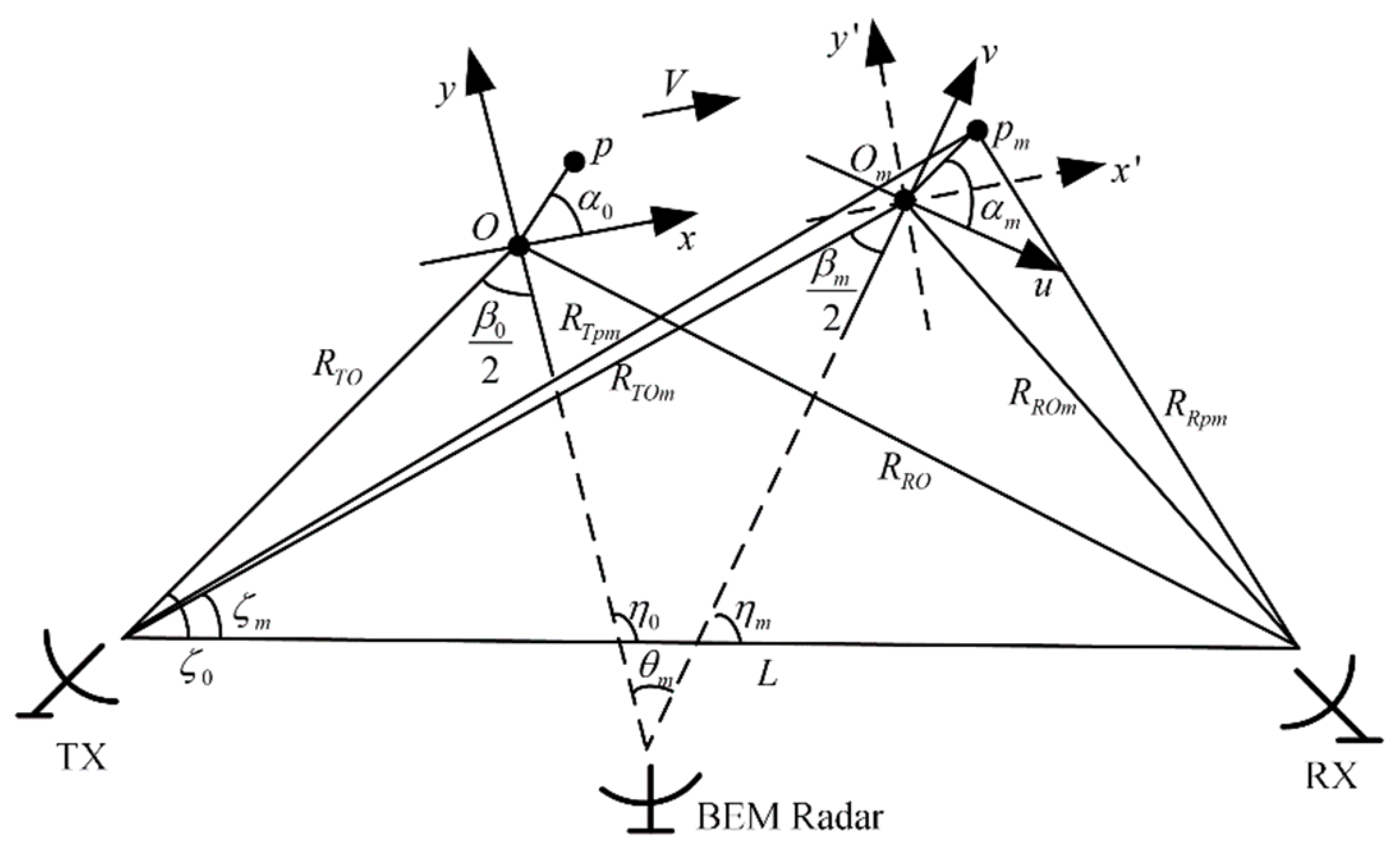

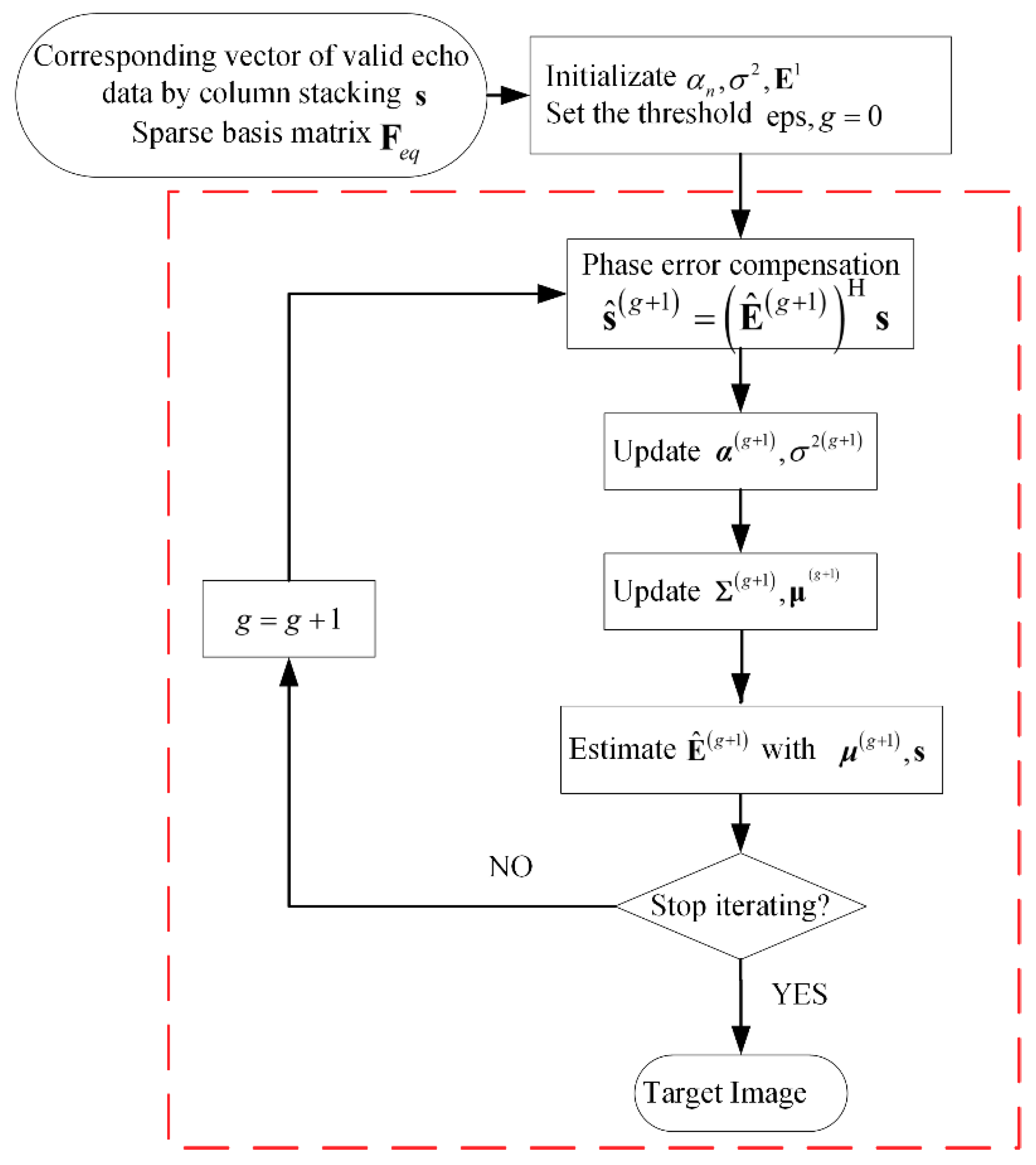
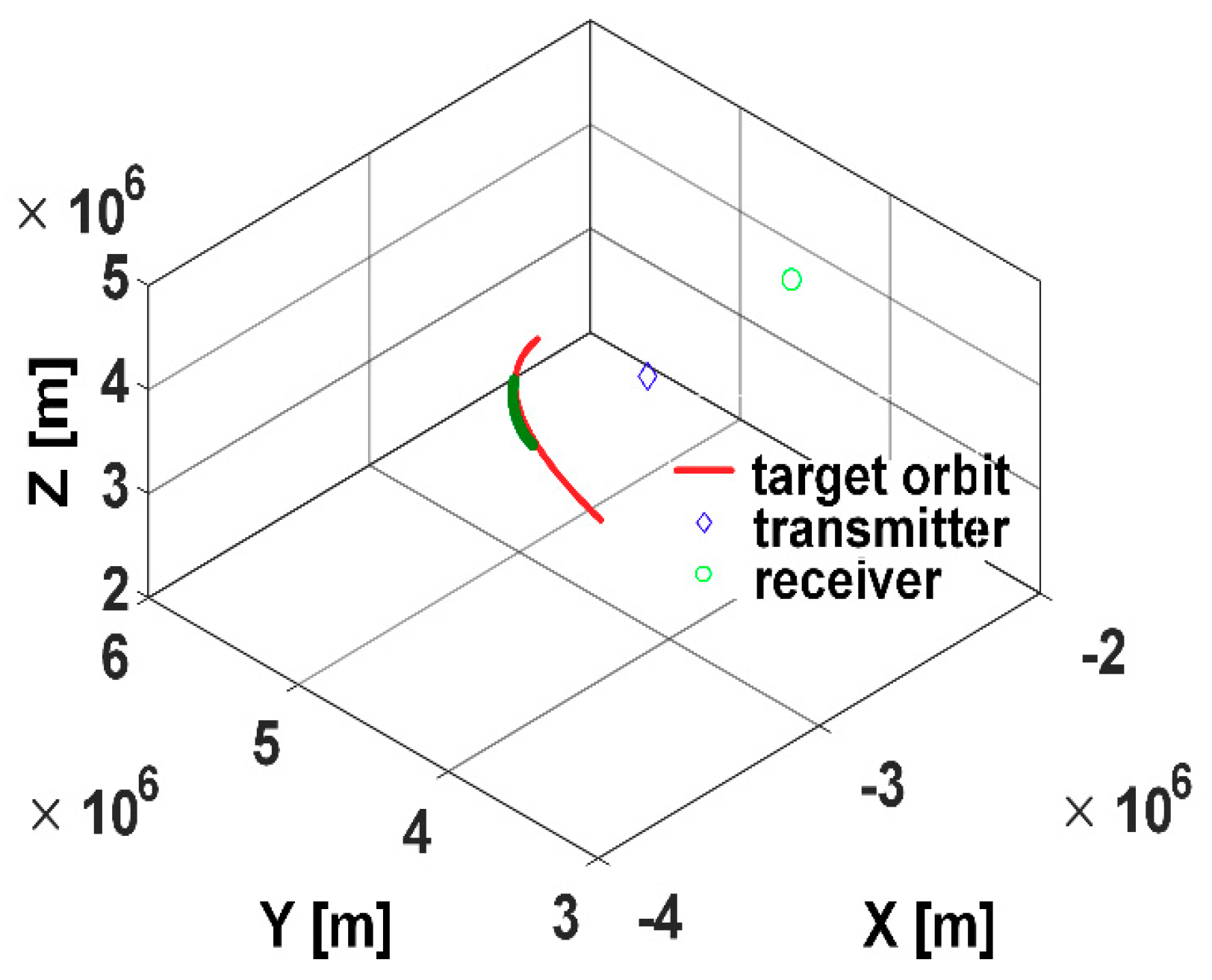
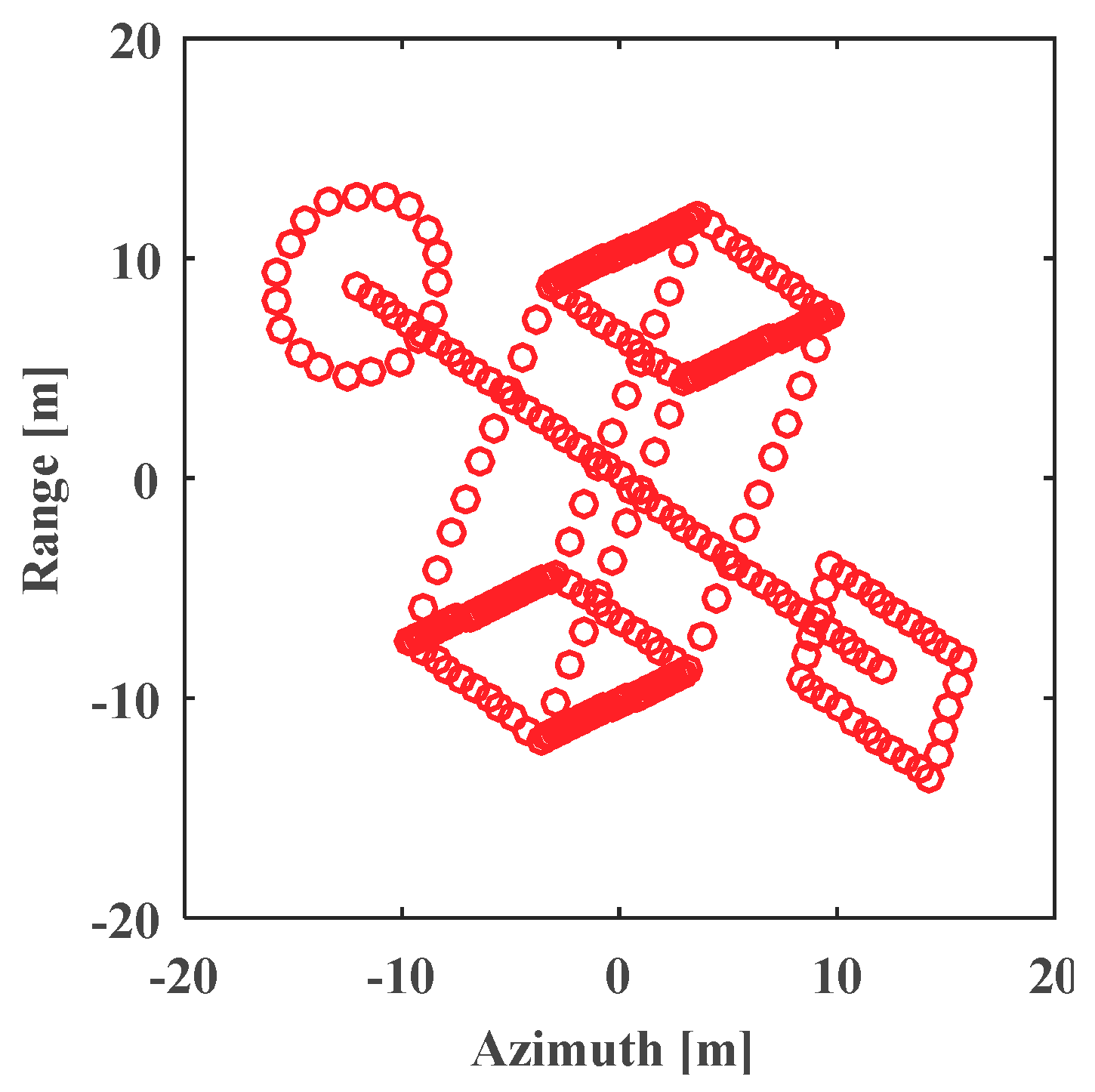






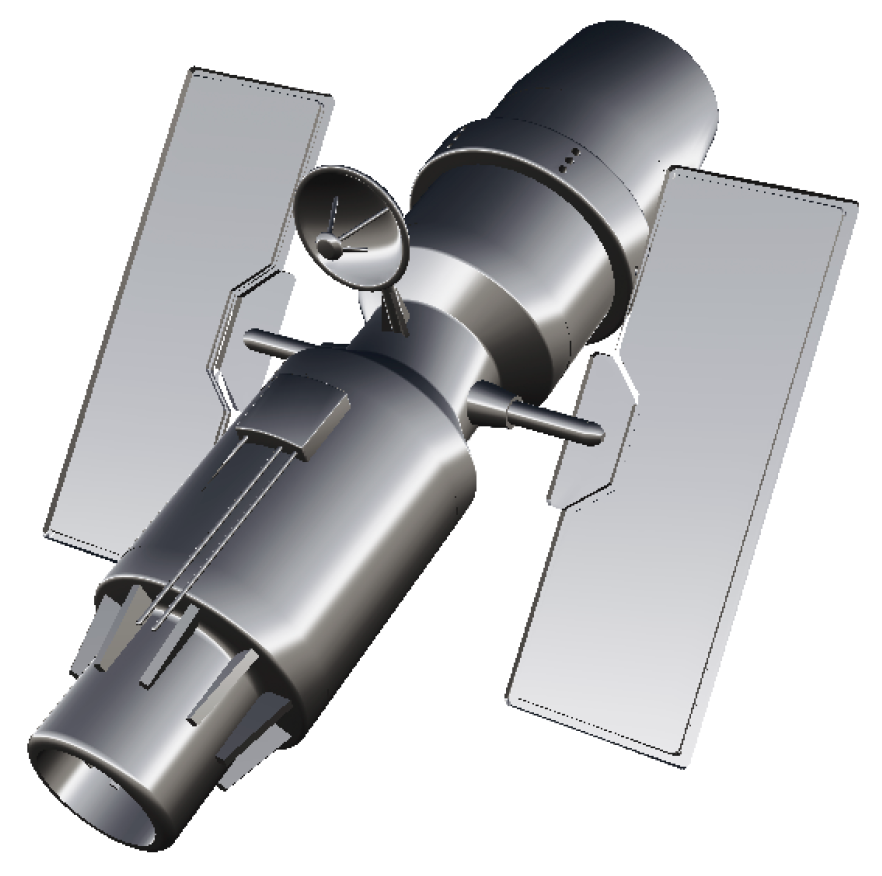






| Parameter Name | Value | Parameter Name | Value |
|---|---|---|---|
| Carrier frequency | 10 GHz | Signal bandwidth | 1000 MHz |
| Pulse width | 20 us | Sampling frequency | 1200 MHz |
| Pulse Repetition Frequency | 50 Hz | Accumulation numbers | 500 |
| Chirp rate | 5 × 1013 | Equivalent Doppler bandwidth | 10 s |
| Range resolution | 0.1809 m | Azimuth resolution | 0.2683 m |
© 2019 by the authors. Licensee MDPI, Basel, Switzerland. This article is an open access article distributed under the terms and conditions of the Creative Commons Attribution (CC BY) license (http://creativecommons.org/licenses/by/4.0/).
Share and Cite
Shi, L.; Zhu, X.; Shang, C.; Guo, B.; Ma, J.; Han, N. High-Resolution Bistatic ISAR Imaging of a Space Target with Sparse Aperture. Electronics 2019, 8, 874. https://doi.org/10.3390/electronics8080874
Shi L, Zhu X, Shang C, Guo B, Ma J, Han N. High-Resolution Bistatic ISAR Imaging of a Space Target with Sparse Aperture. Electronics. 2019; 8(8):874. https://doi.org/10.3390/electronics8080874
Chicago/Turabian StyleShi, Lin, Xiaoxiu Zhu, Chaoxuan Shang, Baofeng Guo, Juntao Ma, and Ning Han. 2019. "High-Resolution Bistatic ISAR Imaging of a Space Target with Sparse Aperture" Electronics 8, no. 8: 874. https://doi.org/10.3390/electronics8080874





